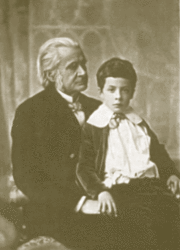The Narmer Palette, also known as the Great Hierakonpolis Palette or the Palette of Narmer, is a significant Egyptian archeological find, dating from about the 31st century BC, containing some of the earliest hieroglyphic inscriptions ever found. It is thought by some to depict the unification of Upper and Lower Egypt under the pharaoh Narmer. Egyptologist Bob Brier has referred to the Narmer Palette as "the first historical document in the world".
Description
Below the bulls' heads flanking the serekh of Narmer is what appears to be a procession, with Narmer shown wearing the red crown of Lower Egypt. He holds a mace and a flail, two traditional symbols of kingship. To his right are the hieroglyphic symbols for his name, though not contained within a serekh. Behind him is his sandal bearer, whose name may be represented by the rosette appearing adjacent to his head, and a second rectangular symbol that has no clear interpretation, though it could also represent the name of a town. Immediately in front of the king is a long-haired man, a pair of hieroglyphs appearing in front of him, which has been interpreted as being his name: Tshet. This is assuming that these symbols had the same phonetic value used in later hieroglyphic writing. In front of this man are four standard bearers, holding aloft an animal skin, a dog and two falcons. At the far-right of this scene are ten decapitated corpses, likely the victims of Narmer's conquest. Above them are the symbols for a ship, falcon and a harpoon, again perhaps indicating the name of the town that was conquered.
Below the procession, two men are tying to gather the outstretched necks of two serpopards, intertwining their necks. The circular formed by their curving necks is the central part of the palette, which is where the cosmetics would be ground. These animals have been considered an additional symbol for the unification of Egypt, but it is a unique image in Egyptian art and there is nothing to suggest that either animal represents an identifiable part of Egypt.
At the bottom of the palette a bull is seen knocking down the walls of a city while trampling on a fallen foe. This is again interpreted as a presentation of the king vanquishing his foes.

 Obverse side
Obverse sideTwo human-faced bovine heads, thought to represent the cow goddess Bat, flank the serekhs, uncharacteristically shown in full frontal view, atypical in ancient Egyptian art. It is also possible that they represent the vigor of the king as pair of bulls.
A large picture in the center of the palette depicts Narmer wearing the white crown of Upper Egypt and wielding a mace. To his left is a man bearing the king's sandals, again flanked by a rosette symbol. To the right of the king is a kneeling prisoner, who is about to be struck by the king. A pair of symbols appear next to his head, perhaps indicating his name, or indicating the region where he was from. Above the prisoner is a falcon, representing Horus, perched above a set of papyrus flowers. In his talons he holds a rope-like object which appears to be attached to the nose of a man's head that also emerges from the papyrus flowers, perhaps indicating that he is drawing life from the head. The papyrus has often been interpreted as referring to the marshes of the Nile Delta region, or that the battle happened in a marshy area, or even that each papyrus flower represents the number 1,000, indicating that 6,000 enemies were subdued in the battle.
Below the king's feet is a third section, depicting two naked, bearded men. They are either running, or are meant to be seen as sprawling dead upon the ground. Appearing to the left of the head of each man is a hieroglyphic sign, the first a walled town, the second a type of knot, likely indicating the name of a defeated town.